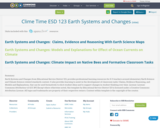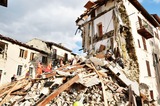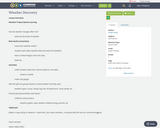Weather Project Based Learning How do weather changes affect me? -what are the kinds of weatherReal world connections -classroom ‘weather station’ -students will collect weather data and report the weather -have a meteorologist come into class -field tripActivities -collect weather data from internet daily for one week -observe outside -make rain gauge?Kids will split into groups based on what weather that they want -weather types; sunny, cloudy, fog, hail, thunderstorm, snow, windy, etcFinal product/presentation description -children’s work product -weather graphs, data, weather related writing, pictures, etcTEMPLATE(Make a copy and go to advance-> share with your team members, & anyone with the link can comment/suggest) Team memberName: Kelly CollinsName: Alexa TrickName: Ginger Boyer Topic: WeatherGrade Level: 1st Grade Part 1: Driving question: (*You should schedule a time to meet with your partners to discuss this before doing Class Prep#7)What are your three initial driving questions?1 What are the different types of weather?2 How do I measure weather?3 What are different types of observing/ analyzing weather?4 What problems need to be solved with the weather?What is your one, final driving question?How do weather changes affect me? Background information of this driving question: What grade level are you working? Which standard are you targeting? Provide any background information the reader should know about this project, such as time span, schedule and so on. Provide a brief introduction to your question as well and an overview to what you envision your lesson looking like. With the crazy weather, we just had on 2-28-17 and 3-1-17 with the rain, wind, hail, and tornado watch, is how we came up with our idea for a weather project based learning. With the crazy weather, we just had, it affected all of us differently and this brought us to our opening question; “How do weather changes affect me?” We decided as a group to focus our project based learning for first grade. As a group, we put down this project would take our class a week and at the end of the week, we would see how engaged the children are with this project to determine if as a class would extend this project longer and more in depth. We would do this project as long as the children are engaged with the project. The standards the children will hit during this project based learning are;S1E1. Students will observe, measure, and communicate weather data to see patterns in weather and climate. a. Identify different types of weather and the characteristics of each type.b. Investigate weather by observing, measuring with simple weather instruments (thermometer, wind vane, rain gauge), and recording weather data (temperature, precipitation, sky conditions, and weather events) in a periodic journal or on a calendar seasonally.c. Correlate weather data (temperature, precipitation, sky conditions, and weather events) to seasonal changes.1.ESS.1 Use observations of the sun, moon, and starts to describe patterns that can be predicted.1.PS.4 Make observations to collect evidence and explain that objects can be seen only when illuminated.1.M.1 Use direct comparison or a nonstandard unit to compare and order objects according to length, area, capacity, weight, and temperature.1.W.4 Apply the writing process.1.W.5 With support conduct simple research on a topic.1.SL.1 List a activity and adjust the use of spoken language to communicate effectively with a variety of audiences and for different purposes.1.SL.2.1 Participate in collaborative conversation about grade appropriate topics and texts with peers and adults in small and larger groups.1.SL.4.2 Add drawings or other visual displays such as pictures and objects, when sharing information to clarify ideas, thoughts, and feelings.1.L.6.4 Demonstrate thoughtfulness and care in creating artwork.1.L.7.6 Demonstrate safe proper use, care, and storage of media, materials, and equipment. With first grade students, we are addressing the weather and the effect that it can have on their lives. The standards that we are addressing are; Why do you think this is a good driving question?Try to answer these 4 questions. (But you should not answer them with yes or no, instead explain the details and convince me that you’ve met these criteria)Does the DQ warrant in-depth study?This project based learning about the weather will help the children have a better understanding of what weather is, how it affects their lives, and how weather operates. If the children are interested in this topic of learning, we could always go deeper into the learning of weather. This topic offers lots of opportunities for learning. Is the DQ an authentic and relevant issue/problem for my students?This topic is very relevant for the children, since they just recently were affected by multiple weather types in less than 24 hours. The multiple weather types are fresh in their minds so they will be eager to want to investigate and learn more about the weather. Is there more than one plausible solution to the DQ?Yes the children will be separated into groups on different types of weather. These groups will be studying and learning about different aspects of weather. The groups will lead their own learning and where it takes them and how they want to present their learning of this part of the weather. With each group studying different parts of the weather, they will all have different solutions of the weather and their groups will be going different routes on their learning and presentations.Does the DQ provide opportunities for students to evaluate, analyze, present, and defend their solutions?Once the group has investigated, analyzed, and learned about their topic of weather, the groups will plan how they want to present their learning to the class. After the group's presentation, their learning of weather, and the class wants to extend their learning or have more questions that we would be able to investigate, analyze, and learn then we will extend their project based learning. Part2: GrabberWhat is your grabber?The main grabber for this topic is the guest speaker, either a meteorologist or someone else well versed in all things of weather. Why do you think this grabber is beneficial and how it align with your driving question?Try to answer these questions. (But you should not answer them with yes or no, instead explain the details and convince me that you’ve met these criteria)· Does the story, article, video, announcement, role play, or other resource hook the learner into asking more questions about the topic?It is always fun to have a guest speaker in your classroom. With the tie in of the meteorologist and with the current crazy weather we had will spike the children’s interest to want to learn more and ask questions regarding weather. · Does the grabber capitalize on novelty and / or high emotion situations?We feel with tiding this project based learning with the crazy weather that we all have experienced and was part of, will help bring high emotion for the children to be happy, excited, and eager to get involved and learn. · Does the grabber establish authenticity & relevance?Weather is part of our everyday life, but with the current crazy weather we have all experienced, it brings relevance to the table and will be a fresh topic in the child’s mind and will be more fun for the children since they have experienced it for themselves. · Make sure to explain in detail how this grabber would be used.We would talk to the children and ask open ended question in regard to the weather and how it affected them, and what they experienced. From here would split the classroom into small groups on different types of weather the children want to focus they’re learning on. From this conversation, would invite and introduce the meteorologist. Once the meteorologist is finished, this will be a time for the children to ask the meteorologist questions in regard to the weather. Once all these questions have been answered, the children will get started on their projects. Culminating activities: List all your activities here: 1) Activity 1· What is your first activity?List the name of your activity here. And explain how it would be implemented in the class, describe the process, such as how to group your students, when to present information to your students, what resources you will use, what students will create or share, etc. Exploring whether and how it affects me, How to measure, observe and analyses the weather, and what problems need to be solved with the weather, will be the focus of the children's investigation and learning. For starters, the class will be discussing about the previous weather we have all experienced. This discussion will lead the children to pick what type of whether they want to learn more about and depending on what weather has been chosen the children will be placed into groups. After the groups, have been established we will invite a meteorologist into the classroom to present and talk about the weather. At the end of the presentation it will be open for the children to ask more questions about their weather they have chosen. From her the children, will work in their groups to study, learn, explore, investigate, analyze the weather for their presentation. The children will work together in their groups about what they want to present, what they learned, the four focusing questions, and how they present their chosen whether. · Why do you think this is a good activity for PBL?Try to answer these 4 questions. (But you should not answer them with yes or no, instead explain the details and convince me that you’ve met these criteria)· How is the activity authentic?This lesson is authentic because this is something that has affected everyone in different ways and something we experience on a daily basis. · Does the activity provide students with the opportunity to present and defend problem solution?This project does allow the children investigate what problem the weather has on us or the environment and give the children the opportunity to come up with a solution to the problem.· Does the activity require student collaboration?The children will be separated into groups by the weather they choose to investigate. In the groups the children will work together. · How will I judge what students have learned from the activity?o You will need to create a rubric for this step and potential example materials as well. 2) Repeat the information above for any additional activities you want to add. PBL Project- Weather Rubric Name of Student:_________________________ Criteria:3 (Excellent)2 (Good)1 (Not So Good)Participation:Student worked efficiently the whole time & didn’t seem distracted.Student was partially participating on the project, was reminded to stay on topic once.Student didn’t participate very much. Didn’t seem interested. Was told several times to stay on task.Effort:Student worked the entire time. Showed effort in the project assigned.Student didn’t put forth a lot of effort, was partially focused.Student showed minimal effort, didn’t seem to care about project or instructions.Final Product:Student final product was finished efficiently, and participated throughout the week.Student had good effort of the visual aid and the project, and was mostly engaged throughout the week. Student had minimal visual aid and minimal presentation of project. Student was engaged very little throughout the week. Total Score:__/ 9 Teacher Comments:




